| This article needs additional citations for verification. Please help improve this article by adding citations to reliable sources. Unsourced material may be challenged and removed. Find sources: "Egyptian Air Defense Forces" – news · newspapers · books · scholar · JSTOR (August 2021) (Learn how and when to remove this message) |
| Egyptian Air Defense Forces | |
|---|---|
| قوات الدفاع الجوي المصري | |
| Founded | 1968 (57 years) 1938–1968 (part of Artillery corps) |
| Country | |
| Role | Anti-aircraft warfare |
| Size | 80,000 active personnel 70,000 reserve personnel 150,000 total personnel |
| Part of | |
| Garrison/HQ | Cairo, Egypt |
| Nickname(s) | حصن السماء Sky Fortress |
| Motto(s) | إيمان, عزم, مجد Faith, Will, Glory |
| March | سلاح الدفاع يرد المغير يصد العدو يلبي النداء |
| Anniversaries | 30 June |
| Engagements | World War II 1948 Arab–Israeli War Suez Crisis North Yemen Civil War Six-Day War War of Attrition Yom Kippur War Gulf War |
| Commanders | |
| Commander, Egyptian Air Defence Force | Major General Yaser El-Toddy |
| Chief of Staff | Major General Ehab El-Faioumy |
| Insignia | |
| Flag |  |
| Insignia | Egyptian Army ranks |
The Egyptian Air Defence Forces (EADF) (Arabic: قوات الدفاع الجوي, romanized: Quwwat El-Difa' El-Gawwi) is the Anti-aircraft warfare branch of the Egyptian Armed Forces. It is responsible for protecting the Egyptian airspace against any hostile air attacks. The EADF was established in accordance with the presidential decree issued on 1 February 1968, which established the Air Defence Forces as the fourth branch, next to the Navy, Egyptian Ground Forces, and Egyptian Air Force. From 1938 onwards air defence forces had been part of the artillery and under the operation command of the Air Force. Egypt has a modern system of air defence armament, which is divided between anti-aircraft missiles long, medium and short-range anti-aircraft artillery systems and early warning radars. Both Western and Soviet bloc countries have supplied equipment.
Officers are mostly graduates of the Egyptian Air Defense Academy, located in Alexandria. The headquarters is in Cairo, and currently the Commander in Chief is Lieutenant General Ali Fahmi and the Chief of Staff is Staff Major General Mohamed Darrag. In 2023 the International Institute for Strategic Studies estimated that the EADF consisted of 80,000 active personnel and 70,000 reserve personnel.
Foundation
After role of aviation expanded during and after the First World War, Egypt saw at that time the formation of a limited force of anti-aircraft artillery enabling it to defend its main cities and economic centers in Cairo and Alexandria. Egypt began to form the first nucleus of the anti-aircraft artillery In 1938, the forces consisted of two regiments of anti-aircraft armed with 3-inch anti-aircraft guns. Since these cannons could not engage at night, as radar had not yet arrived, two searchlight regiments were formed, which were supplied with 90-cm searchlights. Anti-aircraft artillery, with its two sections, became artillery and searchlights, a branch of artillery corps.
World War II
Anti-aircraft artillery entered the battles of the Second World War is still in the cradle of training and development. The air defence battles were fought for the densely populated cities, with Cairo, Alexandria, Port Said and Suez specially important. The first quarter of 1939 was taken to confront the attacks of the Italian and German Air Forces around these cities, and due to the poor quality of the attacking aircraft in addition to the weak level of pilots, Italian aircraft were unable to carry out any successful missions against Egyptian cities except for some limited strikes on residential areas, offset by the shooting-down of a number of aircraft. In June 1941 the German Air Force fiercely developed its attacks on Egypt to cause a moral and material impact for the benefit of the Axis powers, resulting in huge losses of lives and property and did not succeed in achieving actual casualties with military targets, facilities and ports due to the fierce resistance of the anti-aircraft artillery that forced the invading planes to drop their bombs away from vital goals. These continuous attacks enabled the anti-aircraft artillery forces to gain practical experience and identify the tactical shortcomings and work to solve them, so they replaced the 3-inch anti-aircraft guns with their 3.7-inch counterpart with their fixed and mobile types.
Further tactical developments were also made, creating a curtain of intensive fire at a certain point along the plane's flightpath before it reaches the bomb-dropping line, and all its cannons are fired at a specific time that is set according to the speed of the attacking plane and the distance that was discovered, which resulted in good results at that time due to the speed Ltd. limited the quality of the aircraft at that time and the ingenuity of the Egyptian soldiers in the management of the hitting fire. In view of this success and the great effort made by the anti-aircraft artillery officers, the leadership rewarded them by sending them to scientific missions to gain more knowledge and skills at the British Middle East anti-aircraft artillery school.
1948 Arab-Israeli war
After the Arab leaders announced the intervention of the Arab armies to liberate Palestine from the Zionist occupation, several Egyptian army units were ordered at the beginning of May 1948 to go to the eastern borders to participate in the war. A number of anti-aircraft artillery units of small and medium calibers were also dispatched, whose mission was providing protection to ground units against any air attacks by the Israeli forces. Anti-aircraft artillery was successfully able to repel attacks from Israeli aircraft which at the time had limited capabilities and were not able to influence the course of the battles, and due to the losses inflicted on the Israeli air force, anti-aircraft artillery units were able to provide aid to the ground forces in tasks other than air protection, and it was used as anti-tank artillery and as a field artillery, especially in the bombardment of fortified bunkers and Zionist settlements' water tanks.
Suez Crisis

Anti-aircraft guns were one of the Egyptian military strengths of World War II. After the 1952 Coup d'état, further development of anti-aircraft forces was part of Egypt's military buildup.
In mid-1956 the formation of a decent number of units of light and medium anti-aircraft artillery began. Following the outbreak of the Suez Crisis, the Egyptian anti-aircraft artillery forces had to face a large number of modern French and British aircraft, which Egypt's old artillery systems that date back to World War II were no match for, to the point that coalition aircraft were strafing Egyptian soldiers and vehicles with their cannons at low altitudes. Nonetheless, the Egyptian AAA units succeeded at inflicting heavy losses on coalition aircraft, despite the lack of training and outdated equipment they managed to shoot down several aircraft over Cairo, Alexandria and Sinai, and in Suez the Egyptians set up a trap for coalition aircraft that tried to bomb the bridges that link the Sinai Nile Valley and the artillery units managed to foil their attempt at destroying the bridges. And in Port Said the artillery forces managed to hold out for several days against intensive air attacks.
Six-Day War
Main article: Six-Day War
On 5 June 1967, the Israeli Air Force began air strikes on the Egyptian front in Sinai, taking advantage of the shortcomings in the Egyptian air defence. The Israeli Air Force only faced little resistance from obsolete anti-aircraft artillery systems, which were not suitable for dealing with modern, maneuverable high speed aircraft, resulting in a painful loss of life, land and equipment.
War of Attrition
Main article: War of Attrition
Following the 1967 war, Egypt took the decision to reorganise and develop its armed forces, and included those decisions on Presidential Decree No. 199 issued on 1 February 1968, establishment of the Egyptian Air Defence Forces as a separate branch, standing alone, avoiding the previous weapons and units scattered among departments. With artillery and rocket troops were tracing artillery management units and radar warning and operations centers used to belong to the air force and the control points were given follow the Border guard.
And confined all the means and weapons and equipment anti-air attacks under one command to ensure coordination and unification of responsibility and in order to achieve success, and in the 23 June 1969 was appointed Lieutenant General Mohammed Aly Fahmy as the first EADF commander, who took it upon himself to reorganise the forces and the management of cadres and personnel training and increase their level of tactical and tactical mission and technical, with a broad technological base capable of accommodating modern air defence weapons as soon as possible in order to deprive Israel of air superiority. Near the end of the war, on June 30, 1970, Egyptian SAM units shot down four IAF aircraft (2 Skyhawks & 2 Phantoms) from this day to August 6 the EADF shot down 12 IAF aircraft (mostly Phantoms) that this week was nicknamed "Week of the falling Phantoms" this event brought an end to the war and start of Roger's peace negotiations. June 30 has become the EADF anniversary since then.
Early Warning Network
The establishment of the EADF required the establishment of a long-range early warning network to detect any hostile aircraft approaching the Egyptian airspace and provide enough time to warn the air defence and artillery positions, and secure the necessary critical information. This required a large and diverse number of warning systems to be used in full cooperation and coordination, and strengthening it with a network of visual observation points and equipping it with a flexible and continuous transportation network, providing steadfastness to it so that the enemy cannot destroy any part of it or blind it by means of electronic warfare.
SAM Wall
The General Command of the Armed Forces began to support the EADF with modern types of weapons, electronic equipment and anti-aircraft missiles that fly at low altitudes, and the EADF continued to establish sites fortified with the expansion of the country from Aswan to Alexandria and from Port Said to Matrouh, and the state devoted its material and engineering capabilities to build these sites in the shortest possible time, with the preparation of roads and the establishment of telecommunications. The Israeli leadership focused its air strikes on the canal line with the aim of sticking to the ceasefire lines and tightening its grip on that front, and identified the tasks of the Israeli Air Force in destroying Egyptian military sites, especially field artillery shelters, and preventing the establishment of new anti-aircraft missile bases in the channel area, and isolating important areas on The Egyptian front and paralyze any moves aimed at introducing or mobilizing forces in the region. To counter these concentrated air strikes, the EADF introduced anti-aircraft missiles to the canal area, and constructed anti-aircraft missile walls using the slow and steady crawl method by establishing fortifications of each domain and occupying it under the protection of its back-range. Other ranges extend to the middle of the distance between Cairo and the front of the canal, and the necessary field fortifications were established for 24 missile bases. Implementing a plan to deceive and absorb Israeli air strikes by creating structural sites. On the morning of June 30, 1970, Israeli warplanes that chanted Egyptian missiles that inflicted heavy losses on the Israeli Air Force were surprised, so that the rocket wall became a reality, and Israeli Prime Minister Golda Meir stated, In exchange for those great losses that occurred, Israel sought a ceasefire, but in the few hours leading up to the implementation of the ceasefire on August 8, 1970, the EADF managed to complete the missile wall on its final image.
October War
Main article: Yom Kippur WarAfter the Six day war, Egypt managed to form a huge AA Belt of one division placing dozens of SAM battalions (Six missiles each) on the west bank of the Suez Canal. The plan was to repel the anticipated Israeli Air Force Counterattack on the Egyptian forces during Operation Badr using ambush tactics, where between 6 and 8 October alone, around 50 IAF aircraft were shot down. By October 8, the Israeli Air Force warned all their pilots not to fly over Port Said due to the density and danger posed by the Egyptian SAM sites.
After the October war

In 1970 the Egyptian Air Defence Force consisted of four divisions:
- 5th Air Defence Division placed in Cairo. Sami Hafez Anan reportedly commanded this division in 1996–98.
- 8th Air Defence Division placed in Abu Suwayr. Division "crawled forward" in mid 1972 or 1973 to establish AA belt on banks of the Canal. (See Dani Asher, The Egyptian Strategy for the Yom Kippur War, 32)
- 10th Air Defence Division placed in Alexandria.
- 12th Air Defence Division placed in Aswan.
The current structure of the EADF:
- 5th Air Defence Division
- 8th Air Defence Division
- 10th Air Defence Division
- 12th Air Defence Division
- 15th Air Defence Division
- Independent brigades:
- 103rd Air Defence Brigade
- 104th Air Defence Brigade
In 1989 a large share of the EADF's equipment was imported from the Soviet Union. As of 1989, the most modern air defence weapons were the 108 medium altitude I-Hawk SAMs acquired from the United States beginning in 1982. These weapons were supplemented by 400 older Soviet-made S-75 Dvina (SA-2) SAMs with a slant range of forty to fifty kilometers and about 240 SA-3s, which provided shorter-range defense against low-flying targets. A British firm helped the ADF modernize the SA-2s. In addition, Egypt was producing its own SAM, the Tayir as Sabah, based on the design of the SA-2. The ADF had mounted sixty Soviet 2K12 Kub SAMs on tracked vehicles as tactical launchers. Sixteen tracked vehicles provided mobile launching platforms for its fifty French-manufactured Crotale SAM launchers. Egypt was also introducing its own composite gun-missile-radar system known as Amoun (Skyguard), integrating radar-guided twin 23mm guns with Sparrow and Egyptian Ayn as Saqr SAMs.
By the end of 2008, with the support of the United States (through Foreign Military Financing and private contractors and firms) all missile, radar, observation posts, command and control systems were to be linked into a complex multi-level, national computerized early-warning air defence command and control system via modified EC-130H Hercules (modified to AWACS-like specifications) transport aircraft, EW AWACS E-2C Hawkeye 2000, EW ECM Beechcraft 1900 ELINT, and an underground sheltered-reinforced fiber-optic network.
In 2014 the International Institute for Strategic Studies estimated that the EADF consisted of 30,000 officers & soldiers plus 50,000 conscripts.
Commanders of the Egyptian Air Defence Force
- June 1969 to January 1975 Field Marshal Mohammed Aly Fahmy
- January 1975 to December 1979 Lieutenant general Helmy Afify Abd El-Bar
- December 1979 to January 1986 Lieutenant general El-Said Hamdy
- January 1986 to October 1987 Lieutenant general Adel Khalil
- October 1987 to December 1990 Lieutenant general Mostafa El-Shazly
- December 1990 to April 1993 Lieutenant general Zaher Abd El-Rahman
- April 1993 to April 1996 Lieutenant general Ahmed Abou Talib
- April 1996 to 19 July 2001 Lieutenant general Mohammed Elshahat
- 19 July 2001 to 30 October 2006 Lieutenant general Sami Hafez Anan
- 30 October 2006 to 12 August 2012 Lieutenant general Abd El Aziz Seif-Eldeen
- 12 August 2012 to present Lieutenant general Abdul Meniem Al-Toras
- 16 December 2020 to present Major general Mohamed Hegazy Abdul Mawgoud
Weaponry and equipment
The EADF is undergoing extensive modernization with budgetary constraints being the only hindrance. Currently, it is believed to possess the following weaponry:
| Part of a series on |
| Egyptian Armed Forces |
|---|
| Administration |
| Service branches |
| Armies and Military Areas |
| Special Forces |
| Ranks of the Egyptian Military |
| History of the Egyptian military |
Regional/strategic perimeter-level SAM
- Modernized MIM-23 HAWK "Improved HAWK" missile: 18 batteries (6 SP units per battery, 3 missiles per unit plus 2 reloads each) (medium/high-altitude, medium-range SAM)
- 9K37 Buk-M1 missile: 10 batteries purchased in 2005. Each battery is equipped with 4 SP TEL units with 4 missiles each, with 1 reload as reserve.
- 9M317 Buk-M2 missile: Purchased in 2013. . Each battery is equipped with 4 SP TEL units with 4 missiles each, with 1 reload as reserve.
- Modernized SA-3 2M Pechora missile: 43 Batteries (each with 2 stationary units, 4 missiles per stationary unit plus 1 reload each) (low/medium-altitude, medium-range SAM)
- Indigenous Tayer el-sabah (Morning Bird) (reverse-engineered and modernized SA-2 Guideline S-75 Dvina missile: 40 batteries (6 single units per Battery, 2 reloads each) (medium/high-altitude, long-range SAM)
Army corps and division-level SAM
- 9K331 Tor-M1 missile : 16 firing units
- 9K332 Tor-M2 :Purchased in 2013
- Modernized SA-3 2M Pechora missile: 10 Batteries (6 SP units per Battery, 2 missiles per S/P unit plus 1 reload per unit) (Low/Medium Altitude, Medium Range SAM)
- Modernized SA-6 Gainful missile: 14 Batteries (6 SP units per Battery, 3 missiles per unit plus 1 reload each)(Low/Medium Altitude, Medium Range SAM)
Brigade- and battalion-level SAM
- Skyguard "Amoun" anti-aircraft system AIM-7 Sparrow missile: 72 Units " 18 battalion (3 units each) + 4 batteries for training " (2 4-cell Sparrow missile launchers and 2 Oerlikon GDF-005 twin 35mm guns with one Skyguard Fire Control System per battery, 1 reload per launcher) (Original Italian system is equipped with Aspide missile system, substituted with AIM-7 Sparrow missiles with the EADF).
- Modernized Crotale NG missile: 16 Batteries (9 units per Battery, 4 Missiles per unit plus 2 reloads each)(SP Low/Medium Altitude, Short Range SAM)
- MIM-72/M48 Chaparral low-altitude SAM AIM-9 "Sidewinder": 86 SP units (4 Missiles per unit plus 2 reloads each)(SP Low Altitude, Short Range SAM)
- AN/TWQ-1 Avenger : 75 Batteries (4/8 ready-to-fire FIM-92 Stinger missiles + .50 caliber machine gun with an electronic trigger that can be fired from both the Remote Control Unit located in the drivers cab, and from the Avenger turret. Provides mobile, short-range air defence for ground units against cruise missiles, unmanned aerial vehicles, low-flying fixed-wing aircraft, and helicopters.)
Air Defence
| Name | Image | Origin | Type | Variant | Quantity | Notes |
|---|---|---|---|---|---|---|
| S-300 |  |
Long Range Air Defence | S-300VM (SA-23) | 4 Battalions | Preparation to receive the S-300VM were under way in November 2014 First components delivered in March 2015. AA Range = 200 km, AA Ceiling = 30 km, Speed = Mach 5, ABM Range = 40 km. | |
| Patriot Missile | 
|
Long Range Air Defence | (PAC-3) | 32 Missile Systems | Purchased in 1999 . | |
| IRIS-T SLM, SLX, SLS |  |
Medium Range Air Defence | IRIS-T SLM, SLX, SLS | 7 SLM Systems, 10 SLX systems, 6 SLS systems | The German government approved the sale of 7 IRIS-T SLM tactical medium range AD systems to Egypt in September 2018. | |
| Volga |  |
Medium Range Air Defence | Tayer el-Sabah SA-2 |
100 | 100 units were delivered by USSR from 1970 to 1972 for use in the Yom Kippur War. The Egyptians were impressed by the system's performance and acquired a local production license from the USSR. AA Range = 45 km, AA Ceiling = 25 km, Speed = Mach 3.5, ABM = none | |
| Buk |  |
M1-2 M2 (SA-17) M3|| || The Buk-M2 was not previously known to be in Egyptian service until it was revealed in a video of an air defence exercise released on 2 November 2014 by the MoD. | ||||
| MIM-23 Hawk |  |
Phase III | 62 | On 25 February 2014, Egypt ordered new 186 rocket motors to extend the life of their Hawk batteries. Since there are 3 missiles per launch unit then one can deduce that Egypt plans to maintain 62 launcher systems. AA Range = 50 km, AA Ceiling = 14 km, Speed = Mach 2.4 | ||
| Pechora 2M |  |
2M (SA-3) | 70 | Originally Egypt received 200 units from USSR between 1970 and 1972 and they were used extensively during the Yom Kippur War. These units aged and some of them were upgraded to Pechora-2M version. As of December 2008, 70 Pechora-2M upgraded ramp-launched missiles had been ordered by Egypt. AA Range = 35 km, AA Ceiling = 18 km, Speed = Mach 3.1 | ||
| Kub |  |
SA-6 | 56 | Purchased from the Soviet Union after the disastrous 6 Day War and was used to great effect in the Yom Kippur War virtually denying the entire air space of Egypt to Israel. The system was modernized and is still in service. AA Range = 24 km, AA Ceiling = 14 km, Speed = Mach 2.8 | ||
| Tor |  |
Short Range Air Defence | M1 M2 (SA-15) |
16 | 16 units were purchased from Russia. The Tor-M2 was not previously known to be in Egyptian service until it was revealed in a video of an air defence exercise released on 2 November 2014 by the MoD. AA Range = 12 km, AA Ceiling = 6 km, Speed = Mach 2.5 | |
| AN/TWQ-1 Avenger |  |
75 | Egypt originally ordered 50 units, but in 2006 it chose to order a further 25 units which all were delivered by September 2008. AA Range = 8 km, AA Ceiling = 8 km, Speed = Mach 2.2 | |||
| Crotale |  |
VT-1 | 36 | Purchased from France in 1980. AA Range = 11 km, AA Ceiling = 6 km, Speed = 3.53 | ||
| MIM-72 Chaparral |  |
MIM-72C | 280 | Purchased from U.S. stock in 1987,2014 AA Range = 9 km, AA Ceiling = 4 km, Speed = Mach 1.5 | ||
| Strela-1 |  |
SA-9 | 20 | AA Range = 4.2 km, AA Ceiling = 3.5 km, Speed = Mach 1.8 | ||
| Ayn al-Saqr |  |
MANPADS | ||||
| FIM-92 Stinger |  |
|||||
| 9K38 Igla |  |
9K38 / 9K338 Igla | ||||
| M113 AA | 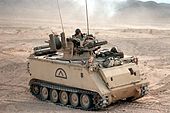 |
SPAAG | Nile 23 Sinai 23 M163 VADS |
Upgraded version of the ZU-23-2 twin 23 mm self-propelled anti-aircraft guns radar guided (148) with Sakr Eye SAM 2X2 on M113, Upgraded version of the ZU-23-2 twin 23 mm self-propelled anti-aircraft guns radar guided with Stinger SAM (3X2) (72) on M113, 108 | ||
| Shilka | 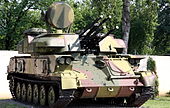 |
350 in 1995. 330 were delivered from USSR, also a new contract was signed with Russia in 2005. | ||||
| ZSU-57-2 | 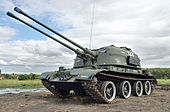 |
40 | 100 ordered in 1960 from Soviet Union and delivered between 1961 and 1962, with 40 remaining in storage today. | |||
| M53/59 Praga | 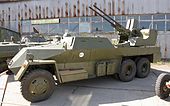 |
|||||
| Skyguard Amoun |  |
Towed AA/SHORAD (35 mm) | Amoun | 36 | 72 GDF units used with one Skyguard unit and two Sparrow SAM launchers per battery | |
| M167 VADS |  |
Towed AA (20 mm) | 72 | |||
| ZPU | 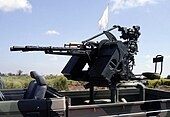 |
Towed AA (14.5 mm) | 200 | |||
| ZU-23-2 |  |
Towed AA (23 mm) | 280 | 280 as Nile 23 and Sinai 23, and 650 upgraded with radar guidance | ||
| 61-K | 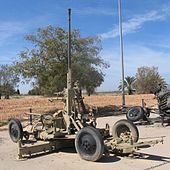 |
Towed AA (37 mm) | 200 | 700 | ||
| S-60 |  |
Towed AA (57 mm) | 200 | 600 | ||
| 52-K |  |
Towed AA (85 mm) | 400 | |||
| KS-19 |  |
Towed AA (100 mm) | 200 | |||
| KS-30 |  |
Towed AA (130 mm) | 120 |
Future of air defence
| System | Image | Origin | Number | Comment | ||
|---|---|---|---|---|---|---|
| Air defence | ||||||
| S-400 Triumf |  |
N/A | Egypt has expressed its interest in buying S-400 systems. | |||
Egyptian Air Defence Radars
| Fan Song | PRV-11 | P-12 radar | Straight Flush | P-19 radar | P-30 radar | P-40 radar | SNR-125 | P-15 radar | Skyguard | Fire Dome | Snow Drift | Scrum Half | engagement | post 3m | ESR-32B | ESR-32A | EADS 3D TRS | AN/SPS-49 | AN/SPS-40 | AN/SPS-67 | ESR-32A | JYL-1 Radar | Selex RAT-31DL | Polyana-D4 | AN/MPQ-50 | AN/MPQ-62 | AN/SPS-48 | AN/MPQ-46 | AN/TPS-59 | AN/MPQ-64 | AN/MPQ-53 | AN/MPQ-65 | AN/VRC-92 | flat box | 1RL33 | RA-20S | P-11 radar | P-14 radar | P-18 radar | P-35 radar | P-40 radar | TIGER | TRS-2100 Tiger | Lion System | JY-9 Radar | YLC-6 Radar | JLP-40 Radar | JLG-43 Radar | AN/TPS-43 | Ground Master 400 | Protivnik-GE | AN/TPS-63 | Giraffe radar | Commander SL | Rezonans NE3
Beret
| Beret | ||
|---|---|---|
| Officer | Brigadier General | General |
 |
 |
 |
Ranks
- Commissioned officer ranks
| Rank group | General / flag officers | Senior officers | Junior officers | |||||||||||||||||||||
|---|---|---|---|---|---|---|---|---|---|---|---|---|---|---|---|---|---|---|---|---|---|---|---|---|

|

|

|

|

|

|

|

|

| ||||||||||||||||
| فريق Fariq |
لواء Liwa |
عميد Amid |
عقيد Aqid |
مقدم Muqaddam |
رائد Ra'id |
نقيب Naqib |
ملازم أول Mulazim awwal |
ملازم Mulazim | ||||||||||||||||
- Other ranks
| Rank group | Senior NCOs | Junior NCOs | Enlisted | |||||||||||||||||||||||||||||||||
|---|---|---|---|---|---|---|---|---|---|---|---|---|---|---|---|---|---|---|---|---|---|---|---|---|---|---|---|---|---|---|---|---|---|---|---|---|
| مساعد أول Mosa'id awwal |
مساعد Mosa'id |
رقيب أول Raqib awwal |
رقيب Raqib |
عريف 'arif |
جندي Jundi | |||||||||||||||||||||||||||||||
References
- ^ International Institute for Strategic Studies (15 February 2023). The Military Balance 2023. London: Routledge. p. 320. ISBN 9781032508955.
- "رئيس أركات قوات الدفاع الجوي". Mod.gov.eg. 24 February 1960. Retrieved 20 May 2020.
- "Egypt". homepages.force9.net. Retrieved 30 March 2016.
- ^ Field Marshal Mohammed Aly Fahmy "Fourth power - the history of the Egyptian Air Defence Forces."ASIN 17292477
- "Al-Ahram newspaper - investigations - Zaher Abdel Rahman, a former air defence commander of the "command and control based on modern warfare."". www.ahram.org.eg. Archived from the original on 20 February 2016. Retrieved 2016-03-29.
- Gen. Yahya Sandzak. "Phantom aircraft downed by "ambush" air defense" – via Al-Watan newspapers.
- "ВКО". old.vko.ru. Archived from the original on 15 March 2016. Retrieved 2016-02-24.
- ^ Metz, Helen; Chapman. "Page 367 of Egypt : A Country Study (Air Defence Forces) /". The Library of Congress, Federal Research Division. Retrieved 17 March 2016.
- International Institute for Strategic Studies (3 February 2014). The Military Balance 2014. London: Routledge. pp. 315–318. ISBN 9781857437225.
- Air Defence Forces. "Commanders of the Egyptian Air Defence Command". mmc.gov.eg/. Archived from the original on 31 December 2012. Retrieved 1 December 2020.
- "Egypt's Reported Acquisition of the S-300VM Air Defense System". Institute for National Security Studies. Retrieved 11 April 2017.
- ""Алмаз-Антей": российская зенитная ракетная система "Антей-2500" поствлена в Египет". ТАСС. Retrieved 14 November 2014.; "Алмаз-Антей : российская зенитная ракетная система Антей-2500 поствлена в Египет". Archived from the original on 12 November 2014. Retrieved 14 November 2014.; ""Алмаз-Антей": российская зенитная ракетная система "Антей-2500" поствлена в Египет". Archived from the original on 12 November 2014. Retrieved 14 November 2014.; ""Рособоронэкспорт" поставит в Египет зенитные системы С-300ВМ". Рамблер-Новости. Retrieved 1 April 2015.
- "According sources, Russia would start deliveries of Antey-2500 missile systems to Egypt". 6 March 2015.
- Kopp, Carlo (23 December 2006). "S-300 & Variants". Air Power Australia: 1. Retrieved 17 April 2015.
- "Raytheon Hails Administration's Decision To Release Patriot for Sale to Egypt". www.defense-aerospace.com. Retrieved 10 April 2021.
- "Egypt | Countries | NTI". www.nti.org. Retrieved 10 April 2021.
- "Federal Government approves arms exports to Gulf States". Rheinische Post. 19 September 2018. Retrieved 19 September 2018.
- "New German-made IRIS-T SLM air defense missile system of Egypt armed forces – Polygonjournal.com". polygonjournal.com. 7 April 2022. Retrieved 3 February 2024.
- Gebauer, Matthias; Schult, Christoph (15 December 2021). "Ägypten: GroKo genehmigte noch kurz vor Regierungswechsel heiklen Waffenexport". Der Spiegel (in German). ISSN 2195-1349. Retrieved 27 December 2021.
- ^ Michael Brzoska; Frederic S. Pearson (1994). Arms and Warfare: Escalation, De-escalation, and Negotiation. Univ of South Carolina Press. p. 96. ISBN 978-0-87249-982-9.
- ^ "Egypt reveals air defence upgrades". janes.com.
- Binnie, Jeremy (26 February 2014). "Egypt, Jordan to extend the life of HAWK missiles". IHS Jane's 360. Retrieved 3 September 2014.
- "S-125". deagel.com.
- IISS 2012 Military Balance, pp. 322
- "Tor (SA-15 Gauntlet)". Military Today.com. Archived from the original on 12 April 2015. Retrieved 12 April 2015.
- "Avenger Low Level Air Defence System, United States of America". Army Technology.com. Retrieved 10 April 2015.
- ^ Anthony H. Cordesman (2004). The Military Balance in the Middle East. Greenwood Publishing Group. p. 185. ISBN 978-0-275-98399-4.
- ^ Thomas W. Zarzecki (2002). Arms Diffusion: The Spread of Military Innovations in the International System. Psychology Press. p. 233. ISBN 978-0-415-93514-2.
- "Egypt buys improved Chaparral" (PDF). Retrieved 23 April 2015.
- ^ "Trade Registers".
- Shlomo Brom; Yiftah Shapir (2002). The Middle East Military Balance, 2001–2002. MIT Press. p. 136. ISBN 978-0-262-06231-2.
- The World Defence Almanac 1995–1996. Military Technology. 1996
- "5. Зенитные Самоходные Установки (ЗСУ) - Военный паритет". www.militaryparitet.com. Archived from the original on 7 December 2008.
- "SIPRI Arms Transfers Database". Armstrade.sipri.org. Retrieved 14 September 2011.
- "Силы и средства ПВО вооруженных сил арабских государств" [The Air Defence Forces of Arab States] (in Russian). Retrieved 6 April 2015.
- "Chief Designer Ardalion Rastov". Military Parade. 31 August 1998. Archived from the original on 23 January 2009. Retrieved 23 August 2008.
- "Egypt wants S-400 to counter Iran". Defaiya.com. 2 July 2009. Retrieved 29 October 2013.
- الدين, نور (29 June 2019). "ما هي مكوّنات قوات الدفاع الجوي المصري؟ وما هي أحدث المنظومات التي تم التعاقد عليها والتي دخلت الخدمة حديثا؟". موقع الدفاع العربي (in Arabic). Retrieved 29 January 2020.
External links
- Unique Surface-To-Air Missile Baffles Foreign Military Diplomats In Egypt
- Jane's Defence news on Egyptian S-125 upgrade, April 2006
- Defencetalk on Egyptian S-125 upgrade, October 2006
- Egyptian President Reinforces Friendship with Russia - Kommersant Moscow
- New ADF commander, ex commander 8 ADD, Major General Mohamed Hegazy Abdul-Mawgoud since January 2016
| Egyptian Armed Forces | |
|---|---|
| Egyptian Air Defense Forces | |||||
|---|---|---|---|---|---|
|